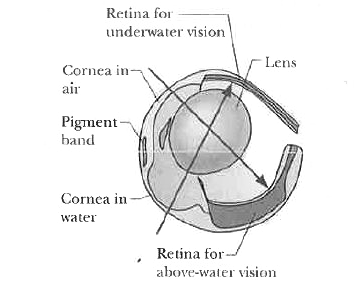Refraction through eye of Anableps anabelps fish
Figure 34-28 shows a vertical cross section through an eye of the Anableps anableps fish that swims with each eye half in and half out of the water, with a pigment band separating the two halves at the water surface. The front of the eye (the cornea) is a spherically convex refracting surface of radius r=1.95mm and index of refraction n2=1.335. The refraction at the cornea is the first step in the eye's focusing of a real image into the back of the eye (the retina), where visual processing begins. If the cornea faces an insect (lunch) at object distance p=0.20m, what is the image distance i of that refraction for the cornea in air (n1=1.000) and in water (n1=1.333) ?
(1) Because the object and its image are on opposite sides of the refracting surface with its convex side facing the object, the situation is like either Fig. 34-24a (for a real image) or Fig.34-24c (for a virtual image).
(2) Image distance and object distance are related by
n1p+n1i=n2−n1r
Calculation : Solving this equation for i gives us
i=n2n2−n1r−n1p
Substituting the given values and using the index of refraction n1=1.000 for air, we find
i=1.3351.335−1.0000.00195−1.0000.20
=8.00mm
Repeating the calculation but using the index of refraction n1=1.333 for water, we find
i=1.3351.335−1.3330.00195−1.3330.20
=−0.237m
Learn : After light is refracted by the cornera, it is further refracted by a lens to give a final real image on the retina. (The function of a lens is discussed in the next section). Our first answer is positive (indicating a real image, as needed) and about twice the diameter of the eye. Thus, the role of the lens in focusing the light onto the retina is moderate because so much refraction occurs at the cornea. Our second answer is quite different : It is negative (indicating a virtual image ) and much larger. So far more focusing is required by the lens to put a real image onto the retina. to provide moderate focusing of light from the water, the eye lens in Anableps anableps is egg shaped, with much greater curvature in the bottom half than in the top.

Topper's Solved these Questions
- GEOMETRICAL OPTICS : REFRACTIONBOOK - RESNICK AND HALLIDAYCHAPTER - GEOMETRICAL OPTICS : REFRACTIONEXERCISE - Check point
6 Videos
- GEOMETRICAL OPTICS : REFRACTIONBOOK - RESNICK AND HALLIDAYCHAPTER - GEOMETRICAL OPTICS : REFRACTIONEXERCISE - Problems
44 Videos
- GEOMETRICAL OPTICS : REFLECTION BOOK - RESNICK AND HALLIDAYCHAPTER - GEOMETRICAL OPTICS : REFLECTION EXERCISE - PRACTICE QUESTIONS (Integer Type)
3 Videos
- GRAVITATIONBOOK - RESNICK AND HALLIDAYCHAPTER - GRAVITATIONEXERCISE - PRACTICE QUESTIONS (INTEGER TYPE)
4 Videos
Similar Questions
Knowledge Check
Refraction of light in the eye occurs at :
Athe lens onlyBthe cornea onlyCboth the cornea and the lensDthe pupilA : The peculiar fish Anableps anableps swims with its eyes partially extending above the water surface so that it can see simultaneously above and below water.
R : This fish has egg shaped eye lens and two retina.AIf both Assertion & Reason are true and the reason is the correct explanation of the assertion, then mark (1).BIf both Assertion & Reason are true but the reason is not the correct explanation of the assertion, then mark (2).CIf Assertion is true statement but Reason is false, then mark (3).DIf both Assertion and Reason are false statements, then mark (4).The part of the eye having the largest refractive index is
ACorneaBAqueous humorCLensDVitreous humor
In a pond of water, a flame is held 2 m above the surface of the water. A fish is at depth of 4 m from the water surface. Refractive index of water is 43. The apparent height of the flame from the eyes of fish is -
View SolutionA convex lens is made out of a substance of 1.2 refractive index. The two surface of lens are convex. If this lens is placed in water whose refractive iondex is 1.33, it will behave as -
View SolutionWhich of the following parts of the eye refracts light?
View SolutionA concave spherical refractive surface with radius R separates a medium of refractive index 5/2 from air. As an object is approaching the surface from far away from the surface along the central axis, its image
View SolutionThe human eye can be regarded as a single spherical refractive surface of curvature of cornea 7.8 mm. If a parallel beam of light comes to focus at 3.075 cm behind the refractive surface, the refractive index of the eye is
View Solution
